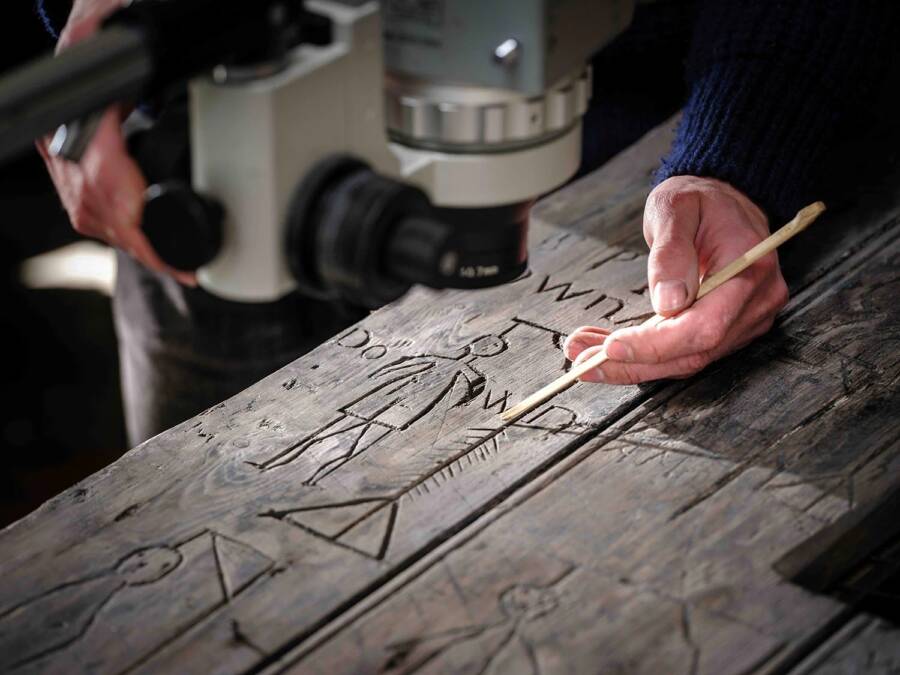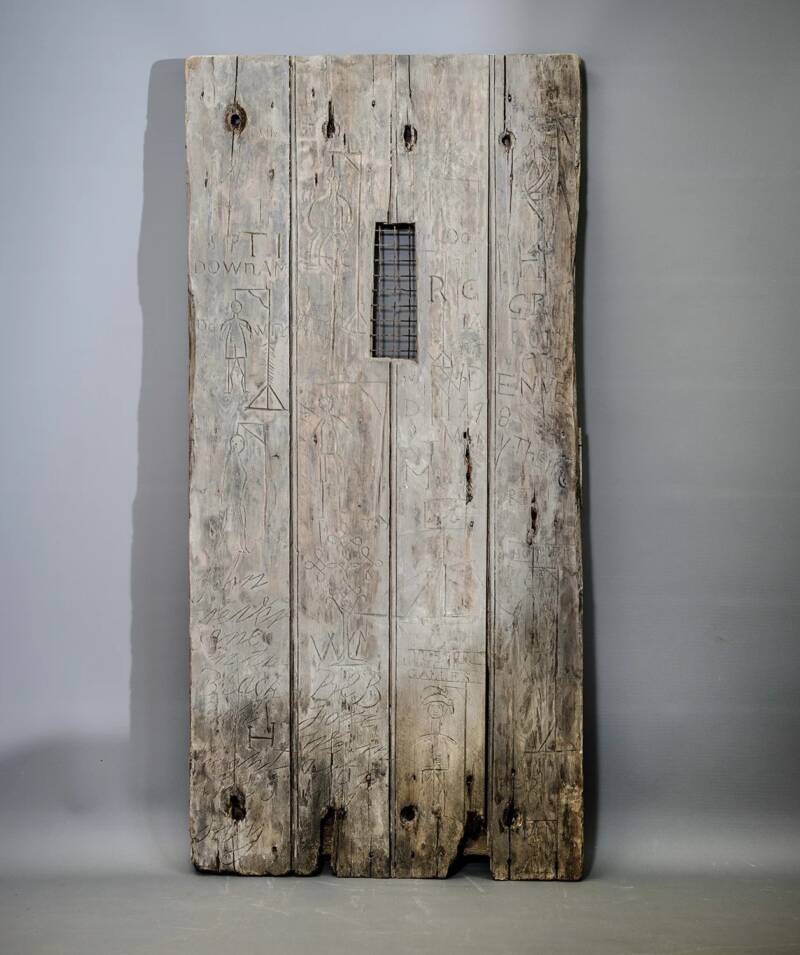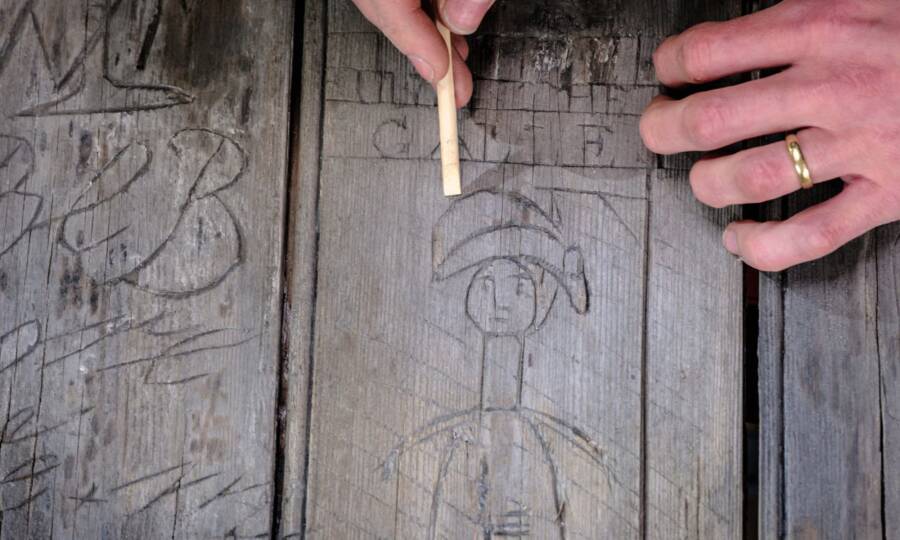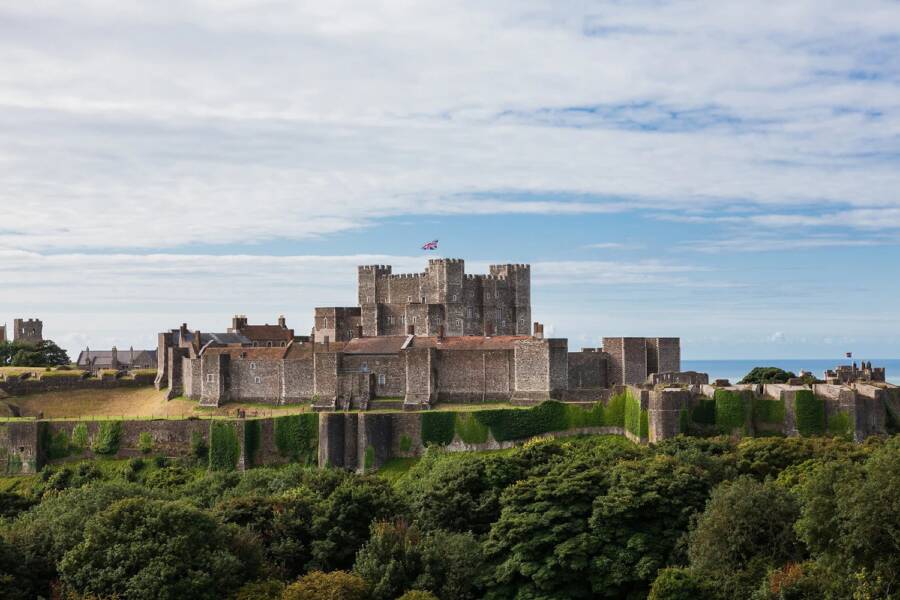The graffiti depicts ships, initials, and several people being hanged — including one that might be Napoleon himself.

English HeritageThe door features 50 pieces of graffiti carved between 1789 and 1855.
For more than a century, St. John’s Tower at Dover Castle in England has been inaccessible, except by ladder. So researchers were astounded when they recently retrieved a door from the tower and discovered that it was covered with dozens of carvings made by English soldiers during the Napoleonic Era.
The graffiti on the door was first carved just after the French Revolution, when Dover Castle became a military garrison in preparation for war with France.
Discovering The Graffiti On The Dover Castle Door
After languishing in St. John’s Tower for more than a century, the graffiti-covered door was recently discovered when castle staff scaled the ladder as part of their “Dover Castle Under Siege” conservation project. Though painted, staff could still make out a glimpse of the carvings beneath.
“Scaling a ladder to the upper floor of St John’s Tower and seeing these remarkable carvings on the door was an astonishing discovery,” Paul Pattison, the senior properties historian at English Heritage, which manages Dover Castle, said in a statement about the discovery.

English HeritageThe door was discovered by castle staff in St. John’s Tower at Dover Castle.
The door bears the mark of 50 individual pieces of graffiti which were carved between 1789 and 1855. They include “a detailed carving of a sailing ship, the date of the French revolution (1789), nine macabre depictions of hangings, and countless initials,” according to English Heritage.
One of the hangings might even be a depiction of Napoleon Bonaparte, the French leader who rose to power after the French Revolution.
“[In one example] a man wears a military uniform and a bicorne hat,” the English Heritage Statement says. “It is possibly a depiction of a real hanging, as hangings took place in Dover and served as morbid entertainment; or perhaps it’s a representation of Napoleon himself.”

English HeritageOne of the nine hangings carved into the door shows a man in a bicorne hat who may be a depiction of the French leader Napoleon Bonaparte.
“This graffiti gives a unique glimpse into the minds of these soldiers,” Pattison explained, “especially during such a charged period of time.”
Indeed, Dover Castle transformed in the wake of the French Revolution as the English braced themselves for a possible war with France.
The History Of Dover Castle After The French Revolution
As revolution and war consumed France at the end of the 18th century, the British fortified themselves for war. Dover Castle, located on the coast of Kent near the English Channel, was swiftly transformed from a medieval castle into a military garrison.

English HeritageDover Castle in Kent, where the graffiti-covered door was discovered in a turret.
“As a result of the impending threat of war from across the Channel, Dover was a hive of activity with ships filling the harbour and colourful military uniforms a constant presence in the castle and town,” Pattison explained.
This sleepy medieval castle was suddenly home to thousands of soldiers and brand new barracks. St. John’s Tower, which has a view over the northern end of the castle, was guarded by six to 12 men at all times. One or two of them would have been posted at the highest part of the tower, where — despite the growing cloud of war — they had plenty of free time.
“With tensions high but hours to kill, it seems those men put their questionable artistic talents to use,” English Heritage notes.

English HeritageWhile guarding the castle, a number of English soldiers passed the time by carving graffiti into the door.
Evidence of the hours they spent guarding the tower and waiting for war with France — which would eventually come with the French Revolutionary Wars and the Napoleonic Wars as the 18th century ended and the 19th century began — remains in the form of the graffiti-covered door. There, soldiers passed the time by drawing ships, their initials, and executions.
“What makes this door such an extraordinary object is that it is a rare and precious example of the ordinary person making their mark,” Pattison remarked, “whether that be simply for the purpose of killing time or wanting to be remembered.”
After reading about this graffiti-covered door discovered at Dover Castle, go inside the surprising true stories of Napoleon’s height and Napoleon’s death.





